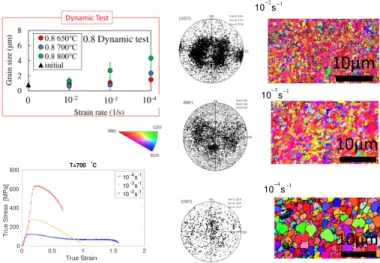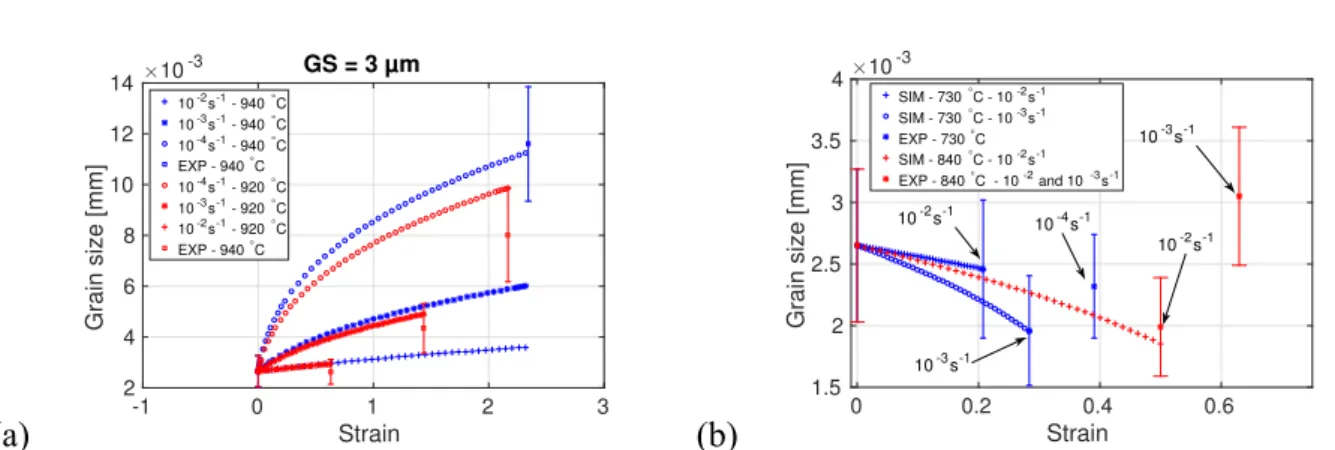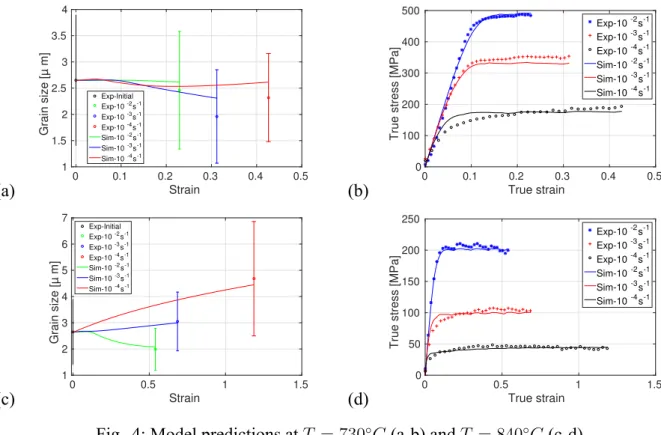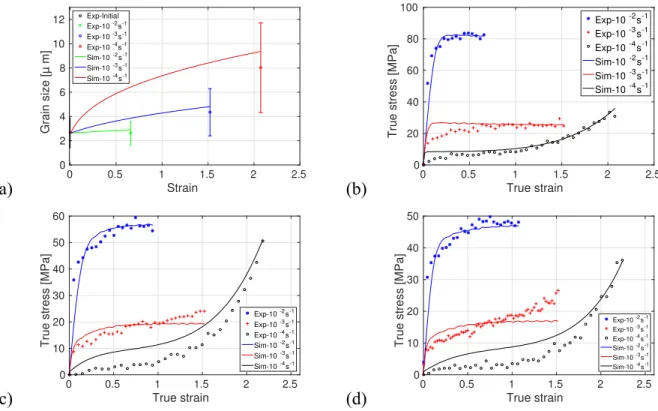HAL Id: hal-01864430
https://hal.archives-ouvertes.fr/hal-01864430
Submitted on 8 Feb 2020HAL is a multi-disciplinary open access archive for the deposit and dissemination of sci-entific research documents, whether they are pub-lished or not. The documents may come from teaching and research institutions in France or abroad, or from public or private research centers.
L’archive ouverte pluridisciplinaire HAL, est destinée au dépôt et à la diffusion de documents scientifiques de niveau recherche, publiés ou non, émanant des établissements d’enseignement et de recherche français ou étrangers, des laboratoires publics ou privés.
Mechanical Behavior of Ti-6Al-2Sn-4Zr-2Mo Titanium
Alloy under Hot and Superplastic Forming Conditions:
Experiment and Modeling
Gen Yamane, Vincent Velay, Vanessa Vidal, Hiroaki Matsumoto
To cite this version:
Gen Yamane, Vincent Velay, Vanessa Vidal, Hiroaki Matsumoto. Mechanical Behavior of Ti-6Al-2Sn-4Zr-2Mo Titanium Alloy under Hot and Superplastic Forming Conditions: Experiment and Modeling. ICSAM 2018 - 13th International Conference on Superplasticity in Advanced Materials, Aug 2018, St Petersbourg, Russia. pp.413-418, �10.4028/www.scientific.net/DDF.385.413�. �hal-01864430�
Mechanical Behavior of Ti-6Al-2Sn-4Zr-2Mo Titanium Alloy under Hot
and Superplastic Forming Conditions: Experiment and Modeling
YAMANE Gen
1,2,a, VELAY Vincent
2,b∗, VIDAL Vanessa
2,c,
and MATSUMOTO Hiroaki
1,d1Department of Advanced Materials Science, Faculty of Engineering, Kagawa University, 2217-20 Hayashi-Cho, Takamatsu, Kagawa 761-0396, Japan
2Institut Clément Ader (ICA), Université de Toulouse, CNRS, Mines Albi, UPS, INSA, ISAE-SUPAERO, Campus Jarlard, 81013 Albi CT Cedex 09, France.
as16g571@stu.kagawa-u.ac.jp,bvincent.velay@mines-albi.fr,cvanessa.vidal@mines-albi.fr, dmatsu_h@eng.kagawa-u.ac.jp
Keywords: Titanium alloy, Behavior modeling, microstructural evolution, HF and SPF processes.
Abstract. Titanium alloys are widely used in the aircraft industry. In sheet form, they can be used
for the manufacturing of pylon or engine parts. With the aim of achieving a cost reduction, this study proposes to act on the starting microstructure so as to improve the mechanical properties during the forming stages. In the present study, investigations are focused on Ti-6Al-2Sn-4Zr-2Mo (Ti6242) al-loy, which is especially used for the hot areas (e.g. parts close to the engine or the combustion cham-ber). A thorough mechanical test campaign was performed on the Ti6242 alloy, examining, on the one hand, the microstructure qualified by the aircraft industry and, on the other hand, a new range of refined microstructures obtained by a hot straining process. For each test, microstructural observations exhibited complex phenomena simultaneously including both grain growth and dynamic recrystalliza-tion. The occurrence, sequencing and coupling of the mechanisms were all strongly dependent on the starting microstructure and the test conditions (time-temperature and strain rate) investigated. They are not easy to understand and require further tests and observations. In such a framework, the imple-mentation of mechanical models is an efficient and relevant way of gaining a better knowledge of the microstructural evolution observed and its influence on the mechanical behavior.
Introduction
Ti6242 alloy is used in the aircraft industry for the manufacturing of parts that can be used for thermal protection in hot areas. Its in-service behavior at high temperature is greatly improved compared to Ti-6Al-4V alloy, which is the most conventional titanium alloy [1]. Presently, the complex shapes are obtained by a Superplastic Forming process (SPF), require high forming temperatures (≥ 900◦C)
and are not easy to form. However, this alloy demonstrates good mechanical behavior at high tem-peratures and a reduced cost compared to a Nickel-based Superalloy. This work proposes to act on the starting microstructure so as to improve the mechanical properties during the forming stages. The final objectives are to decrease the forming temperature and increase the strain rate. In order to en-sure this, the microstructural evolution and the deformation mechanisms acting on the mechanical behavior will be identified for a large number of test conditions. Three starting equi-axed microstruc-tures were investigated and compared by performing a thorough test campaign, including mechanical and annealing tests. These tests examined, on the one hand, the microstructure qualified by the aircraft industry and, on the other hand, a new range of refined microstructures obtained by a hot straining pro-cess. Depending on the test conditions, microstructural observations exhibited complex phenomena, simultaneously including both grain growth [2, 3] and dynamic recrystallization (DRX) [4]. These phenomena greatly influence the mechanical behavior with regard to strain hardening or softening, and can drastically reduce the maximal elongation or, on the contrary, increase it. In this paper, the proposed model is able to take into account the effects of strain rate sensitivity, hardening or softening
associated with complex microstructural evolution. The model components use several results taken from the literature to describe the material viscosity [5], the strain hardening effect due to grain growth [2] or the softening phenomenon due to DRX [4, 6, 7].
Mechanical and Microstructural Investigations
The material investigated is a near-α Ti6242 Titanium alloy with an equiaxed microstructure. It is a creep resistant alloy used for high temperature applications [1]. In the present work, three starting mi-crostructures were investigated with average grain sizes of 0.8, 3 and 6µm. In order to investigate the influence of the loading path on the mechanical behavior of each starting microstructure, two kinds of tests were performed. First, annealing tests allowed observation of the microstructural evolution under static conditions, e.g. evolution only due to the temperature levels and the exposure times. Secondly, dynamic tests were conducted by using a tensile test machine that gives accurate readings for the high elongations. The tests considered a furnace with three heating zones ensuring a negligible thermal gradient during the deformation process. In this case, a temperature range between 650◦C and 960◦C
and several strain rates from 10−4s−1 to 10−2s−1 were considered for each starting microstructure. The static tests did not reveal significant grain size evolution for the starting microstructure of 6µm regardless of the test conditions, whereas evolution occurred for the other starting microstructures whose evolution increased with the temperature and the time. Moreover, the evolution rate was higher for the Ultra Fine Grain microstructure (0.8µm). Fig. 1 shows the grain size evolution during the an-nealing tests for the starting microstructure of 3µm. A slight evolution can be observed below 840◦C,
whereas a significant increase occurs from 920◦C.
Fig. 1: Grain size evolution during the annealing tests at several temperature levels from 730◦C to
920◦C and an initial average grain size of 3µm
The elongation tests conducted at 650◦C and 700◦C for the starting microstructure of 0.8µm
showed a plasticity mainly governed by dislocation motion at the higher strain rate (10−2s−1), whereas complex interactions seem to be initiated for the lower ones (10−3s−1 and 10−4s−1). Indeed, EBSD analysis revealed a random texture and considerable grain growth, which increased with the test tem-perature. Moreover, at 10−4s−1, the strain-stress response exhibited a slight softening before a station-ary behavior which might be due to a dynamic recrystallization effect, as shown in Fig. 2.
At 800◦C, Grain Boundary Sliding (GBS) occurred regardless of the strain rate and very significant
grain coarsening was observed at the lower strain rate, inducing a strain hardening effect observed in the tensile test. Similar analysis was conducted on the starting microstructure of 3µm. In this case, the material exhibited interactions between dynamic recrystallization and grain growth at intermediate temperatures (730◦C ≤ T ≤ 840◦C), with grain growth predominant at T ≥ 900◦C, whereas no
evolution was observed at low temperature (T ≤ 730◦C). Lastly, the starting microstructure of 6µm
shows an unexpected result with a significant grain growth (700◦C ≤ T ≤ 900◦C) from 10−2s−1
10−2s−1
10−3s−1
10−4s−1
Fig. 2: Grain size evolution observed during the tensile test for an intial average grain of 0.8µm, sev-eral temperature levels (from 650◦C to 800◦C) and strain rates (from 10−4s−1 to 10−2s−1); influence of the loading path on the texture evolution and its interaction with the strain-stress response at 700◦C
growth effect. The results provided by the tensile tests enhance this observation with a strain hardening occurring first and inducing a higher stress level at 5.10−4s−1 compared to 10−3s−1 before a stress decrease and an additional steady state behavior.
Behavior Modeling
In this section, constitutive equations are identified from the tests performed on the starting microstruc-ture of 3µm. In the first stage, the parameters of evolution laws [2, 4, 5] able to describe both static and dynamic grain growth are identified. The identification procedure was not easy because, depend-ing on the test conditions, interactions between grain growth and dynamic recrystallization can occur sequentially. Therefore, test conditions only inducing grain growth were selected to determine the pa-rameters. Then, some data from the literature were used to validate the methodology [5]. The models used are recalled in Eq. 1 (static case) and Eq. 2 (dynamic case). A1, A2, m1, m2and n1are temperature
dependent parameters and ˙p is the cumulative inelastic strain rate.
˙
dsta = A1d−m1 (1)
˙
ddyn = A2d−m2p˙n1 (2)
The model predictions are in quite good agreement from 730◦C to 960◦C in the case of the static
tests. Fig. 2a shows the comparison between computed results and experiment for the dynamic tests and the higher temperatures (T ≥ 920◦C) where grain growth is predominant. The results are
com-pared to the empirical law provided in the works of Semiatin [8]. The tensile tests performed at lower temperatures (T ≤ 840◦C) are used to identify the dynamic recrystallization phenomenon. In this case,
the evolution law is first calibrated using Eq. 3. Fig. 2b presents some results provided at T = 730◦C
and 840◦C.
˙
ddrx=−A3dm3p˙n2 (3)
The constitutive equations consider an internal variable d related to the microstructural evolution. This variable is defined by the contribution due to the dynamic recrystallization and the grain growth effects under static and dynamic conditions (See Eq. 4). According to the previous discussion, the influence of each contribution strongly depends on the test conditions (temperature and strain rate).
Table 1: Constitutive equations used in the behavior model formulation
˙
d = ˙dsta+ ˙ddyn+ ˙ddrx (4)
In the next step, the microstructural variable is coupled with a behavior model that is able to describe the viscoplastic behavior and take into account the interaction with the strain-stress response of the material. Table 1 summarizes the model components. The evolution equation related to the description of the dynamic recrystallization effect (Eq. 3) is modified to be written as a function of the volume fraction of recrystallized material S (see Eq. 5) [4]. In this case, the initial parameter calibration is used to determine the final parameters A3, m3 and m4.
˙ ddyn=−A3S˙m4dm3 (5) (a) Strain -1 0 1 2 3 G ra in s iz e [ m m ] ×10-3 2 4 6 8 10 12 14 GS = 3 µm 10-2s-1 - 940°C 10-3s-1 - 940°C 10-4s-1 - 940°C EXP - 940°C 10-4s-1 - 920°C 10-3s-1 - 920°C 10-2s-1 - 920°C EXP - 940°C (b) Strain 0 0.2 0.4 0.6 G ra in s iz e [ m m ] ×10-3 1.5 2 2.5 3 3.5 4 SIM - 730°C - 10-2 s-1 SIM - 730°C - 10-3s-1 EXP - 730°C SIM - 840°C - 10-2s-1 EXP - 840°C - 10-2 and 10-3s-1 10-3s-1 10-2s-1 10-3s-1 10-2s-1 10-4 s-1
Fig. 3: Comparison between computed grain growth curves and experiment under dynamic conditions from 920◦C to 940◦C (a) and from 730◦C to 840◦C (b).
The behavior model considers a von Mises yield criterion in order to describe the transition be-tween elastic and viscoplastic behavior. σ0 is the initial elasticity limit of the material. The criterion
evolution is defined through an isotropic hardening variable R. Three contributions are introduced into the evolution equation of the internal variable ρ associated with the variable R.
The first term allows the influence of several starting microstructures on the hardening evolution to be taken into account, while the second term provides a description of the stationary behavior of the hardening and the last one enables consideration of a softening term induced by a dynamic recrystal-lization effect. d0is the initial grain size and b1, b2and Q are temperature-dependent parameters. S is
the recrystallized volume fraction variable, which is formulated as a function of the internal variable
ρ and of the product of two terms related to the fraction of mobile boundaries. Its form is deduced
sensitivity of the alloy, is written using a hyperbolic sine form of the yield function f , where α1, α2
and µ are temperature-dependent coefficients. The stress rate equation is classically written in uniaxial form and considers a partition of the total strain rate into elastic and inelastic parts. E is Young’s mod-ulus. Lastly, at high temperature, when a significant grain growth effect is observed, the asymptotic value Q of the isotropic hardening variable R is considered as a function of the grain size range ∆d through two other coefficients Q0and b0. The calibration of each model parameter was performed at
each temperature level. Firstly, the microstructural coefficients were determined from the analysis of the microstructural evolution. Then, the tensile tests provided the hardening and viscous parameters. Lastly, a fine tuning process combining a global and a local optimization procedure (Genetic Algo-rithm and Levenberg-Marquardt methods) was implemented. Fig. 4 illustrates the model predictions at 730◦C (a-b) and 840◦C (c-d). The computed results are in a good agreement with the experiment,
both in terms of grain size evolution under dynamic conditions where mainly dynamic recrystallization occurs, and in the strain-stress response. Fig. 5 shows the model capabilities for other test conditions from 920◦C to 960◦C where grain growth is predominant, involving a significant strain hardening.
(a) Strain 0 0.1 0.2 0.3 0.4 0.5 G ra in s iz e [ µ m ] 1 1.5 2 2.5 3 3.5 4 Exp-Initial Exp-10-2s-1 Exp-10-3s-1 Exp-10-4s-1 Sim-10-2s-1 Sim-10-3s-1 Sim-10-4s-1 (b) True strain 0 0.1 0.2 0.3 0.4 0.5 T ru e s tr e s s [ M P a ] 0 100 200 300 400 500 Exp-10-2s-1 Exp-10-3s-1 Exp-10-4s-1 Sim-10-2s-1 Sim-10-3s-1 Sim-10-4s-1 (c) Strain 0 0.5 1 1.5 G ra in s iz e [ µ m ] 1 2 3 4 5 6 7 Exp-Initial Exp-10-2s-1 Exp-10-3s-1 Exp-10-4s-1 Sim-10-2s-1 Sim-10-3s-1 Sim-10-4s-1 (d) True strain 0 0.5 1 1.5 T ru e s tr e s s [ M P a ] 0 50 100 150 200 250 Exp-10-2s-1 Exp-10-3s-1 Exp-10-4s-1 Sim-10-2s-1 Sim-10-3s-1 Sim-10-4s-1
Fig. 4: Model predictions at T = 730◦C (a-b) and T = 840◦C (c-d)
Summary
The following summary and conclusions can be drawn from this work:
• the mechanical behavior of Ti6242 titanium alloy was investigated under hot forming conditions • constitutive equations were identified to describe the mechanical response as well as the
asso-ciated microstructural evolutions.
• several test conditions were taken into account, which induced various mechanisms (grain growth, DRX) involving hardening or softening.
• complex interactions can occur at intermediate temperatures and should be investigated in more detail in further studies in order to enhance the model capabilities.
(a) Strain 0 0.5 1 1.5 2 2.5 G ra in s iz e [ µ m ] 0 2 4 6 8 10 12 Exp-Initial Exp-10-2s-1 Exp-10-3s-1 Exp-10-4s-1 Sim-10-2s-1 Sim-10-3s-1 Sim-10-4s-1 (b) True strain 0 0.5 1 1.5 2 2.5 T ru e s tr e s s [ M P a ] 0 20 40 60 80 100 Exp-10-2s-1 Exp-10-3s-1 Exp-10-4s-1 Sim-10-2s-1 Sim-10-3s-1 Sim-10-4s-1 (c) True strain 0 0.5 1 1.5 2 2.5 T ru e s tr e s s [ M P a ] 0 10 20 30 40 50 60 Exp-10-2s-1 Exp-10-3s-1 Exp-10-4s-1 Sim-10-2s-1 Sim-10-3s-1 Sim-10-4s-1 (d) True strain 0 0.5 1 1.5 2 2.5 T ru e s tr e s s [ M P a ] 0 10 20 30 40 50 Exp-10-2s-1 Exp-10-3s-1 Exp-10-4s-1 Sim-10-2s-1 Sim-10-3s-1 Sim-10-4s-1
Fig. 5: Model predictions at T = 920◦C (a-b), T = 940◦C (c) and T = 960◦C (d)
References
[1] E-L. Odenberger, R. Pederson, Mats Oldenburd, Thermo-mechanical material response and hot sheet metal forming of Ti6242, Mat. Sc. And Eng. A. 489 (2008) 158-168.
[2] V. Velay, H. Matsumoto, V. Vidal, A. Chiba, Behavior modeling and microstructural evolutions of Ti-5Al-4V alloy under hot forming conditions, Int. J. of Mech. Sc.. 109-109 (2016) 1-13. [3] M.W. dos Santos, V. Velay, V. Vidal, G. Bernhart, G. F. Batalha, H. Matsumoto, Mechanical
behavior of a Ti-6Al-4 V titanium alloy with microstructural evolution modeling under hot and superplastic conditions, Mat.-wiss. u. Werkstofftech., 48 (2017) 952-961.
[4] E. Alabort, D. Putman, R.C. Reed, Superplasticity in Ti-6Al-4V: Characterization, modelling and applications, Acta Mat. 95 (2015) 428-442.
[5] J. Lin, T. Dean T, Modeling of microstructure evolution in hot forming using unified constitutive equations, J. Mater. Process. Technol. 167 (2–3) (2005) 354-362.
[6] J. Lin, Y. Liu, D.C. Farugia, M; Zhou, Development of dislocation-based unified material model for simulating microstructure evolution in multipass hot rolling, Phil. Mag. 85 (2005) 1967-1987. [7] L. Yang, N. Li, B. Wang, J. Lin, H. Zhao, W. Ma, Unified constitutive modelling for two-phase
lamellar titanium alloys at hot forming conditions, Manuf. Rev. 3 (2016).
[8] S.L. Semiatin, P.N. Fagin, J.F. Betten, A.P. Zane, A.K; Ghosh, G.A. Sargent. Plastic flow and microstructure evolution during low-temperature superplasticity of ultrafine Ti–6Al–4V sheet material, Metall Mater Trans A – Phys Metall Mater Sci 41A(2) ( 2010) 499–512.




